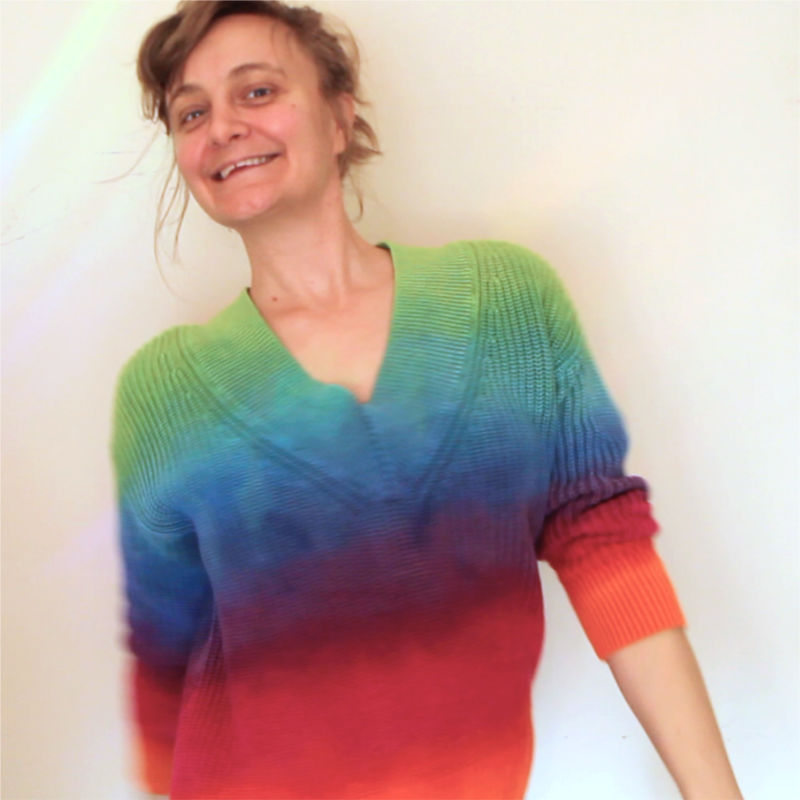Blog / 2023 / Rainbow Dye Magic
December 7, 2023
To make your own rainbow dye magic, you’ll need a couple hours to paint the dye, at least twelve hours to let the dye and fixer do their work, and a few hours to rinse the item and then launder it. These are the supplies:
- an item of clothing that’s 100% cotton
- soda ash
- dyes
- synthrapol
- water
- rubber gloves
- a bucket for the soda ash soak
- containers for the individual dye colors
- a teaspoon
- a measuring cup
- chopsticks for mixing dye and water
- sponge brushes
- rags
- a plastic sheet
- plastic bags
The soda ash, dyes, and synthrapol I use are all Jacquard Procion. They’re not nice chemicals—especially the soda ash—so please don’t use supplies that are usually involved in food prep to get your dye project done. I recommend using rubber gloves, containers, a teaspoon, a measuring cup, chopsticks, and rags that won’t be touching food again.
For more inspiration, check out this old post about pants I’ve dyed.

VIDEO TRANSCRIPT
Making a rainbow magic sweater like this one is as simple as buying an item at a thrift shop that’s 100% cotton and light enough in color to take the dye—even this oatmeal color is plenty light enough.
And then you need to assemble your supplies!
First, some soda ash to activate and fix the dyes. It comes as a powder and you mix it with water for soaking your item. You can keep reusing soda ash, so I’ve got a bottle of it ready to go.
While the sweater steeps for twenty minutes, mix up the dyes. I use Jacquard Procion MX Dyes. They’ve been my go-to for thirty years because only on a handful of occasions have my dyed items tainted other clothing when washed in the same load, and only when the dye job includes fuchsia or red dyes. In other words, Jacquard Procion MX Dyes are good quality.
It’s two teaspoons of pigment per cup of warm water. I mix a little bit of water into the dye first and then add progressively more so that the dye doesn’t clump. The pigments I’m using to make this rainbow are bright green, aquamarine, medium blue, marine violet, fuchsia, and brilliant orange.
Once the sweater has soaked for twenty minutes, I take it out of the soda ash bath, wring it out, and pat it dry with clean rags. I lay out the sweater and start applying the dye with sponge brushes, ideally one for each color of dye. I apply all the stripes. I do a little bit of blending, but mostly I focus on making sure that the color goes through both layers of fabric. And I touch up on the bottom layer of fabric—which is to say the back of the sweater—where needed.
Some people recommend doing your dye painting not on a surface like this one, which is my kitchen floor covered in plastic sheet. Instead, they lay the clothing out on a grill—something like a cookie cooling rack—so that the extra dye drips through and can’t pool and spread on the fabric.
I don’t have a grill big enough for a sweater like this, so I’m just careful. When I put the item into plastic bags to sit overnight, I stuff clean rags around it stop the warmer colors from running into the cooler ones as the sweater compresses from me moving it around.
When pinks and purples run, it looks like this. Not terrible, but not necessarily what I was going for either.
I’m going to show you the plastic bag packing part of process again, because I want you to note how I wrap the green end of the sweater in one bag and the orange end in another, and then I put the whole thing in another bag to sit overnight. I’m doing that so that I don’t get green in my orange or orange in my green.
The next day, I wash the dye out by hand with warm water. At this point the dye is fixed, so I don’t worry too much about green and orange bits touching each other. The rinsing out is a long process and it can be tiring for your hands and wrists, but it’s important. Then the sweater is ready for a wash in a machine, first with a dash of Synthrapol and a second time with regular detergent. At this point it’s finally ready to be laundered normally with other clothing.
And, of course, to be worn with the special delight of a hand-dyed item!
Maybe this post made you think of something you want to share with me? Or perhaps you have a question about my art? I’d love to hear from you!
To receive an email every time I publish a new article or video, sign up for my special mailing list.
If you enjoyed this post, Ko-fi allows you to donate. Every dollar you give is worth a bajillion to me!



